Asia: Japan -
Korea - China
 So far, hosta species have only been found to
be native to parts of Asia. The largest number come from the various
islands of Japan while smaller collections of species originated in
Korea and China. Several European plant explorers "discovered"
hostas and started to bring them back to be introduced into Europe
several centuries ago.
So far, hosta species have only been found to
be native to parts of Asia. The largest number come from the various
islands of Japan while smaller collections of species originated in
Korea and China. Several European plant explorers "discovered"
hostas and started to bring them back to be introduced into Europe
several centuries ago.
The first documentation of the genus,
Hosta,
came from a medical doctor with the Dutch East India Company named
Engelbert Kaempfer (1651-1715). Dr. Kaempfer was stationed in
Japan but was segregated on a tiny island by the Japanese rulers and was not permitted to
travel around on his own. Somehow, he was able to get local Japanese
to bring him plants and he made a drawing of one that was later
identified as Hosta 'Lancifolia'. Unfortunately, he was not able to
bring back any live specimens to his native Europe.
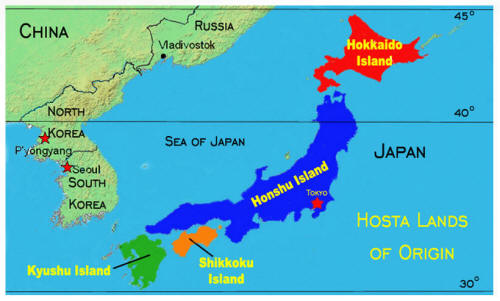
Although, by far, most species of hostas come
from Japan, the first two plants to be introduced into Europe came
from China. It is believed that
Hosta
plantaginea was first
grown in Paris at the
Jardin des Plantes in the mid-1700s while
Hosta
ventricosa found its way to a private garden in London about the
same period. According to
Zilis (2009),
Hosta lancifolia,
H. plantaginea,
H. ventricosa and H. 'Fortunei' were the
first hostas to be introduced into Europe.
Two of the primary early explorers who were
later able to actually bring hostas back to Europe from Asia were
Philip von Siebold (1796-1866) and
Robert Fortune (1812-1880).
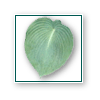 Von Siebold was also
a medical doctor from the
Netherlands who traveled to Japan in 1823. He was able to acquire
many Japanese plants that he later brought back to Europe. He
returned on a second trip in 1859 and had more freedom to roam
around the islands to collect plants. Among these were several
species of hosta. Back in Holland, von Siebold was instrumental in
setting up the first botanical garden at the
University of Leiden.
Von Siebold was also
a medical doctor from the
Netherlands who traveled to Japan in 1823. He was able to acquire
many Japanese plants that he later brought back to Europe. He
returned on a second trip in 1859 and had more freedom to roam
around the islands to collect plants. Among these were several
species of hosta. Back in Holland, von Siebold was instrumental in
setting up the first botanical garden at the
University of Leiden.
Perhaps the most common hostas of all belong to
the large, blue-green leaf species that bears his name,
Hosta sieboldiana (now H. 'Sieboldiana'). It comes from Honshu
Island in Japan. The other plant,
Hosta sieboldii, is a small plant with narrow leaves that
have a slender, white margin of variegation. There is also some
debate as to whether this is a true species but, so far, it remains
listed as such.
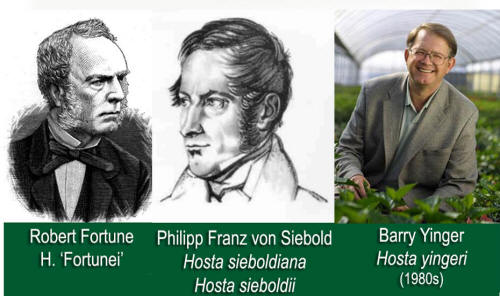
Robert Fortune was one of the first European
plant explorers to be allowed to wander freely around China to collect
plants. He was educated at the
Edinburgh Botanic Garden in Scotland and worked for the Royal
Horticultural Society at their gardens in
Chiswick in
England. They sponsored his expeditions to gather
exotic plants to bring back to Great Britain.
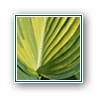 In addition to rhododendrons and many, many
other plants, Fortune brought hostas back to Europe. One was given
his name as a species, Hosta fortunei but
Schmid (1991) found
no evidence that this plant actually came from the wilds so it was
reclassified as a cultivar, Hosta 'Fortunei'. This confusion
occurred probably because the people back in Europe figured that the
plants all came from wild populations. In reality, the local
Japanese people who procured some of the plants for the explorers
may have gotten them from private or temple gardens where they had
been growing in cultivation for hundreds of years.
In addition to rhododendrons and many, many
other plants, Fortune brought hostas back to Europe. One was given
his name as a species, Hosta fortunei but
Schmid (1991) found
no evidence that this plant actually came from the wilds so it was
reclassified as a cultivar, Hosta 'Fortunei'. This confusion
occurred probably because the people back in Europe figured that the
plants all came from wild populations. In reality, the local
Japanese people who procured some of the plants for the explorers
may have gotten them from private or temple gardens where they had
been growing in cultivation for hundreds of years.
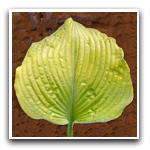 Modern day plant explorers continue to
periodically scour Japan, Korea
and China in search of new species
of plants that might be prime for introduction into America, Europe
and other countries. In fact, in 1985, an American horticulturist,
Barry Yinger, was searching in remote areas of South Korea when he
discovered two new species of hosta. One of them was named in his
honor as
Hosta yingeri and the other was
H. jonesii.
The second new species was named for botanist
Dr. Samuel B. Jones of
the University of Georgia who helped Yinger identify the plants.
Modern day plant explorers continue to
periodically scour Japan, Korea
and China in search of new species
of plants that might be prime for introduction into America, Europe
and other countries. In fact, in 1985, an American horticulturist,
Barry Yinger, was searching in remote areas of South Korea when he
discovered two new species of hosta. One of them was named in his
honor as
Hosta yingeri and the other was
H. jonesii.
The second new species was named for botanist
Dr. Samuel B. Jones of
the University of Georgia who helped Yinger identify the plants.
The native lands of hostas are in East Asia
generally between 30 and 45 degrees north latitude. As you can see
on the map, this roughly corresponds to just below the border with
Canada in the north down to the Gulf of Mexico in the south. Some
hostas are grown in areas north of the 45th parallel especially in
the Pacific Northwest where winters are mild or in places like
Minnesota which generally receive good snow cover.
A greater challenge for hosts occurs in certain
areas between the 30th and 45th parallels because of hot, dry
summers. In the United States, for instance, it is difficult to grow
hostas in parts of California, Nevada and Arizona because of the
lack of rainfall and, in some cases, the absence of winter cold.

Mr. PGC Comment: An interesting fact is
that most of
Great Britain lies north of 45 degrees latitude but they have
the benefit of warm sea water that moderates their climate year
around. Their winters tend to be warmer and summers are often cooler
than other areas of the world at a similar latitude such as the
upper peninsula of Michigan.



